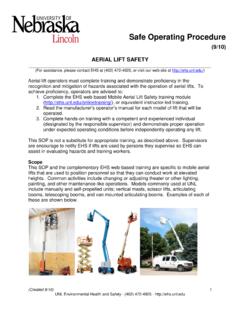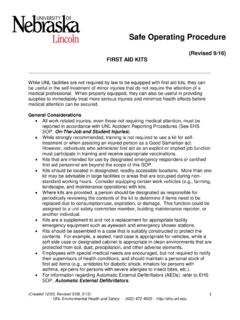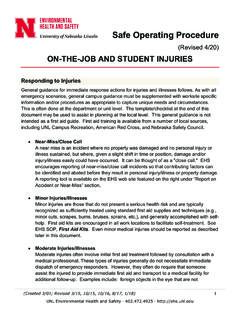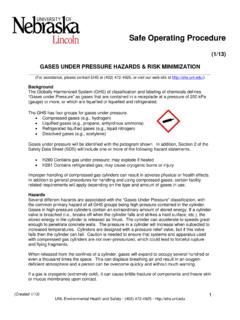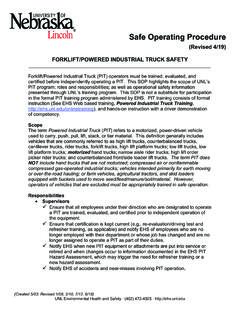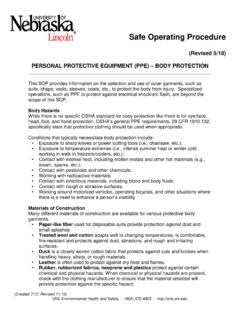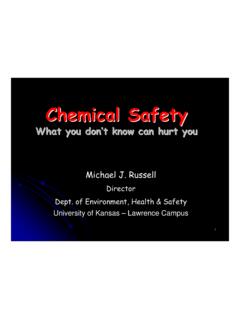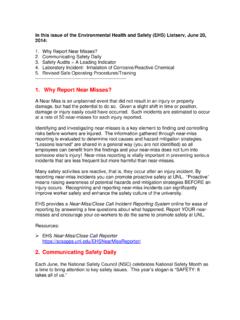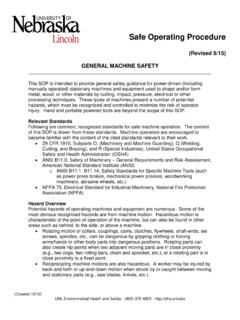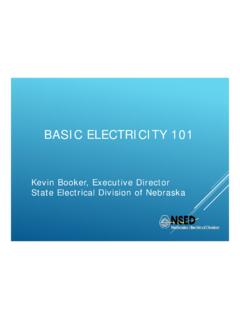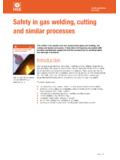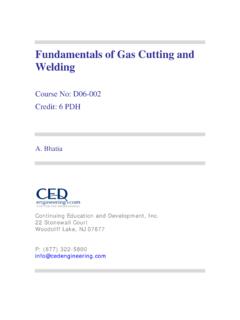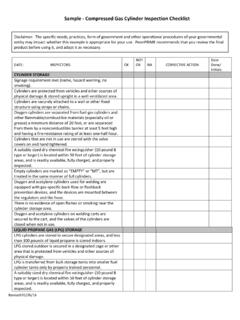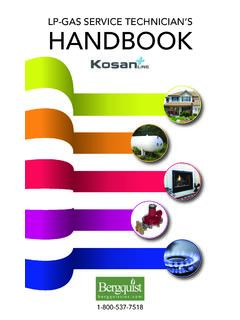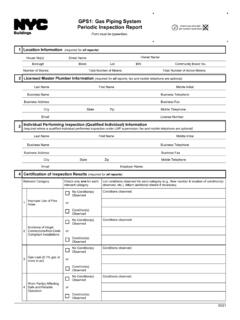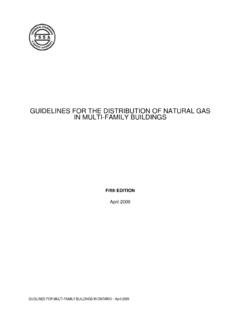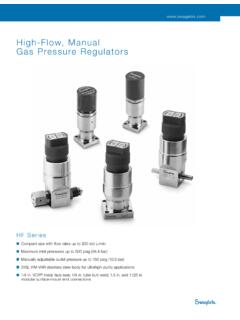Transcription of Compressed Gas Safety.ppt - University of Nebraska–Lincoln
1 Confidential1 Compressed Gas SafetyConfidential2 OSHA Regulations 29 CFR Compressed GasesConfidential3 Hazards of Compressed Gas CylindersChemical HazardsPhysical HazardsConfidential4 Compressed GasesChemical Hazards Inerts Oxidizers Flammable ToxicConfidential5 Chemical Hazards of Compressed Gas Cylinders Confidential6 OxidizersOXYGEN & GAS MIXTURES OXYGEN CONCENTRATION > ALLOW PETROLEUM BASED PRODUCTS TO COME INTO CONTACT WITH FROM COMBUSTIBLES & FLAMMABLES IN STORAGE. 20 DISTANCE, OR 5 HIGH, 1/2 HOUR FIRE WALLC onfidential8 OxygenOdorless, colorless gasNon flammable but is necessary for other material to burnHyperoxiaConfidential9 Oxygen CylinderConfidential10 InertsNITROGEN, ARGON,HELIUM, CO2 Simple Asphyxiantswhich can displace oxygenWill not support lifeConfidential11 InertsUSE IN WELL VENTILATED AREASDO NOT DISPOSE OR VENT OFF UNUSED FOR OXYGEN > WHEN USED IN CONFINED SPACEC onfidential12 InertsConfidential13 ArgonOdorless, colorless gasCan be stored with flammables or , PROPANE.
2 PROPLYENEGas flammables in concentration of 13% or less in air by volumeGas in flammable range greater than 12% by volumeConfidential15 FlammablesSTORE IN A WELL VENTILATED LOCATIONKEEP AWAY FROM HEAT SOURCESSTORE AWAY FROM OXIDIZERS AND COMBUSTIBLESC onfidential16 FlammablesConfidential17 AcetyleneSlight garlic like odorBurns easily in air LEL 99% UELMay be explosive under high pressure Used at 15 psi or lessConfidential18 Tox i c sARSINE, NITROGEN DIOXIDE, BORON TRICHLORIDE Material capable of causing death or serious debilitationIn absence of data on human toxicity tested on laboratory animals has a LC50 valueConfidential19 Tox i c sConfidential20 Cylinder IdentificationEvery Gas Cylinder or Vessel Must Be Clearly Labeled Product Name DOT ID Number DOT Hazard Class Manufacture Name & Location Precautionary StatementConfidential21 Cylinder IdentificationNever rely on color of cylinder for of cylinder may vary by manufacturer or use product label to properly identify IdentificationNever modify, cover or remove a cylinder label becomes illegible or detached Write product name with black marker.
3 Mark as contents unknown if unknown. Contact manufacturer or Hazards of Compressed Gas CylindersPressureWeightStabilityMechanic al FailureMovementConfidential24 Recognize the HazardsPressureCauses Typical High Pressure Cylinders have 1800 3000 PSI Not regulating pressureConsequences Uncontrolled release Activation of relief device Container failureConfidential25 Recognize the HazardsWeightCauses This stuff is heavy Nitrogen 160 251 lbs Argon 450 1059 lbsConfidential26 Recognize the HazardWeightConsequences Smashed finger Back strain Broken foot Internal injuries AmputationConfidential27 Recognize the HazardStabilityCauses Naturally unstable Transitions Uneven surfaces Debris on floorsConsequences Falling cylinder Falling
4 Piles Liquid container tipping overConfidential28 Recognize the HazardsMechanical Failure Cylinder Valves RegulatorConfidential29 Recognize the HazardsMechanical FailureCauses Over pressurization Backflow Flashback Damaged in transportation Worn threads Valve packing and seatsConsequences Flying debris Property damage Injury/DeathConfidential30 Recognize the HazardMovementCauses Lose of control while rolling Trying to catch falling cylinders Miss alignment of cart hooks Failure to secure to cartConfidential31 Recognize the HazardsMovementConsequences Smashed hand Back strain Shoulder strain Broken foot Internal injuries Finger amputationConfidential32 Cylinder StorageStore in dry, ventilated from falling or from falling not use as a door valve closed when not in use.
5 Confidential33 Cylinder StorageStore with valve closed and cap tighten not store in extreme temperatures near flames or direct ice and snow accumulate on cylinders, thaw at room not store near StorageFuel gas Always in upright position. 20 feet from oxygen & combustible material. Never place anything on top of 20 feet from flammable or combustible can be 1 hour fire in use or connected can be stored HandlingPersonal Protective EquipmentConfidential36 Cylinder Handling Protect valve, couplings, regulators, hose and apparatus from oil & drop or strike a not lift cylinder by not weld on lift HandlingIf cylinder does not have a fixed valve handle, a non adjustable wrench must be with the cylinder while in must be closed before moving a cylinder.
6 Unless secured to a cart, regulator must be removed and cap in Handling Check container for bulges, dents, container and valve for not direct a gas stream directly at any must be kept away from actual hot work area to protect from sparks, slag, need a check valve to prevent & RegulatorsNever attempt to repair or modify a attaching to cylinder Stand to one side of cylinder outlet Open valve slightly, then close Never use Teflon tape on a CGA fittingBefore removing from cylinder Close cylinder valve Release gas from regulatorConfidential40 Cylinders & Valve Leaks NEVER USE A LEAKING to stop leak by closing outdoors & away from ignition sources, allow to slowly or mark cylinder to warn others that it is & FireMove cylinders away from fire if water to keep cylinders emergency personnel of type & amount of gas on Information Sources Product Label Safety Data Sheet Response Guidebook Confidential43 SummaryQuestions
